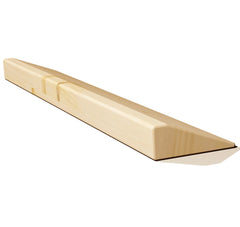What is a Wood Yoga Slanting Plank?
In the slanting plank, the wooden prop can be placed under the hands, feet, or other parts of the body to create an inclined surface. This can help to increase the difficulty of poses like downward dog, plank, or warrior poses by requiring more strength and balance. It can also be used to modify poses for those with limited flexibility or mobility.
Wood slanting planks are popular in yoga studios and home practice, as they are durable, easy to clean, and provide a stable and safe support for yoga poses. They can be used in combination with other yoga props like blocks, straps, and blankets to create a customized yoga practice that meets the individual needs and goals of the practitioner.
How to use a slanting plank?
 To use a wood slanting plank in yoga, follow these steps:
To use a wood slanting plank in yoga, follow these steps:
-
Choose the appropriate slanting plank based on your yoga practice and level. There are different sizes and angles of slanting planks available, so it's important to choose one that suits your needs.
-
Place the slanting plank on a flat and stable surface, like a yoga mat or a hardwood floor.
-
Use the slanting plank to modify or enhance your yoga poses. For example, you can place the plank under your hands in downward-facing dog to create a deeper stretch in the shoulders and upper back. You can also place the plank under your feet in warrior II pose to deepen the hip opening and increase the intensity of the pose.
-
Experiment with different placements and angles of the slanting plank to find what works best for your body and your practice. You can adjust the angle of the plank to make it more or less challenging, or use it in combination with other props like blocks or straps.
-
Be mindful and listen to your body as you use the slanting plank. Don't push yourself beyond your limits, and if you feel any discomfort or pain, back off or modify the pose accordingly.
History of the Slanting Plank
The use of modern wooden props like slanting planks in yoga emerged in the 20th century as yoga began to gain popularity in the West. Yoga teachers and practitioners in the West began to experiment with different props to enhance and modify yoga poses, and wooden props like blocks, straps, and slanting planks became common tools in yoga studios and home practice.
The wood slanting plank for yoga is closely related to Iyengar yoga, a style of yoga developed by B.K.S. Iyengar, one of the most influential yoga teachers of the 20th century. Iyengar yoga is known for its emphasis on alignment, precision, and the use of props to support and enhance yoga poses.
In Iyengar yoga, wooden props like blocks, straps, and slanting planks are used extensively to help students achieve proper alignment and deepen their practice. The slanting plank is particularly useful in Iyengar yoga for its ability to provide a stable and adjustable support for poses that require strength and balance, such as arm balances, inversions, and standing poses.
Iyengar himself was known for his innovative use of props, including the development of the wooden slanting plank. He used the plank in a variety of poses, including standing poses, forward bends, and inversions, and emphasized its benefits for increasing strength, flexibility, and stability in the body.
Today, the wood slanting plank is commonly used in Iyengar yoga classes around the world, and is considered an essential prop for practitioners of this style of yoga.
Buy your wood slating plank online here.

